Diamonds are the hardest natural substance yet found, pure crystallised carbon formed in the earth’s mantle well before life on the planet…pretty cool when you think that we are talking about something that is around 2 billion years old. They sure are tough, but can they be broken? Well in fact the answer is a big YES. Damage generally occurs when pressure or force is brought to bear on the diamond, most commonly in areas that are cut to a fine edge (the girdle), or sharp pointed areas like the corners of the princess cut or the pointy end of a pear shape diamond. Also, the culet (the bottom end of a diamond) can be a risky area in some ring designs. A damaged diamond may be completely worthless if it cannot be re-cut. Even re-cutting is not a perfect solution, as you may lose symmetry and of course lose weight and size.

Super Hard Diamonds But be Careful
Damage Can Arise in a Number of Ways
Diamonds can be damaged during the cutting or setting process, because it is tricky to cut or set diamonds and often the need to get the diamond in just the right position in the ring puts pressure on areas we would really rather not… however that is the discipline of working with diamonds. Diamond setters have a risky task ahead of them when setting a diamond. No diamond setter has a 100 % success (no breakage) rate, because it is simply not possible to set diamond rings without risk. Luckily the best setters know the various risks involved with each diamond type and claw / ring design, so can minimise the potential for damage to occur, but even with all the care in the world and the greatest degree of skill, breakages still occur from time to time. This is part of the reason why we do not work with diamonds supplied by clients, as the question then arises, who should take on this risk?
Care Should be Taken When Wearing Your Engagement Ring if you Don’t Want a Damaged Diamond
Mistreating your engagement ring can result in a damaged diamond. You have to be quite unlucky, but it is possible to chip a diamond with rough treatment. Activities such as going to the gym, heavy lifting, housework and gardening should not generally be done whilst wearing your engagement ring. Insurance does not as a rule cover wear and tear on jewellery but will often cover accidental damage. The trouble arises in the interpretation of what constitutes normal wear and tear.
Accidental damage may be covered by your insurance. A common accident that can result in a damaged diamond is dropping the ring onto a hard surface such as tiles or a concrete floor. There are many things you could be doing with a ring on your finger when it gets caught up, or knocked on something. It is accidental and obviously unintended, that still does not make you feel any better about it. It is wise to think about what you are doing and the task ahead. If you would not do it whilst holding something delicate …think about the ring …and maybe remove the risk by taking it off.
Engagement rings can of course be set with other precious gemstones. None are as hard as diamonds, although others such as sapphires come close. No matter what your engagement ring is set with, always take care of your jewellery. Every engagement ring is precious, and should be treated that way. After all an engagement ring is likely ( for most people ), to be the most valuable item of jewellery they possess, to say nothing of the great sentimental value of the ring, not only to you, but to your entire family.
Take great care of your engagement ring and enjoy wearing it, but always think about what you are doing to it in the tasks you undertake.
You can read more about how to take care of your engagement ring in this link: questions.
